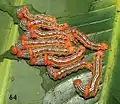| Dunama indereci | |
|---|---|
 | |
| Male | |
 | |
| Female | |
| Scientific classification | |
| Domain: | Eukaryota |
| Kingdom: | Animalia |
| Phylum: | Arthropoda |
| Class: | Insecta |
| Order: | Lepidoptera |
| Superfamily: | Noctuoidea |
| Family: | Notodontidae |
| Genus: | Dunama |
| Species: | D. indereci |
| Binomial name | |
| Dunama indereci Chacón, 2013 | |
Dunama indereci is a moth in the family Notodontidae. It is found in Costa Rica, where it is known from the Villa Blanca, in San Ramon, Alajuela province, at an elevation of 1,115 meters in a montane pass between Costa Rica’s Cordillera de Tilaran and the Volcanica Central.[1]
Description
The length of the forewings is 11.8–12.9 mm. The dorsal ground color is a mixture of gray-brown and beige scales. The veins are lined with gray, especially distally. The anal fold and cubitus are light brown and the orbicular spot is blackish brown. The reniform spot is diffuse and blackish brown and the fringe is gray brown. The dorsal hindwing is gray brown. The ventral surfaces of both wings is gray brown.
Biology
The larvae feed on Heliconia latispatha.
Etymology
The species is named in honor of the International Development Research Centre (IDRC) of Canada in recognition of their support of information management and DNA barcode taxonomy at INBio for conservation, and particularly for its support of the International Barcode of Life Project (iBOL initiated by the Biodiversity Institute of Ontario at the University of Guelph, Canada).
Gallery
 Larvae - intermediate instar
Larvae - intermediate instar Larvae - last instar
Larvae - last instar
References
- ↑ Chacón, I.A. ; D.H. Janzen ; W. Hallwachs ; J.B. Sullivan & M. Hajibabaei, 2013: Cryptic species within cryptic moths: new species of Dunama Schaus (Notodontidae, Nystaleinae) in Costa Rica. Zookeys 264: 11-45. Abstract and full article: doi:10.3897/zookeys.264.4440
 Media related to Dunama indereci at Wikimedia Commons
Media related to Dunama indereci at Wikimedia Commons Data related to Dunama indereci at Wikispecies
Data related to Dunama indereci at Wikispecies